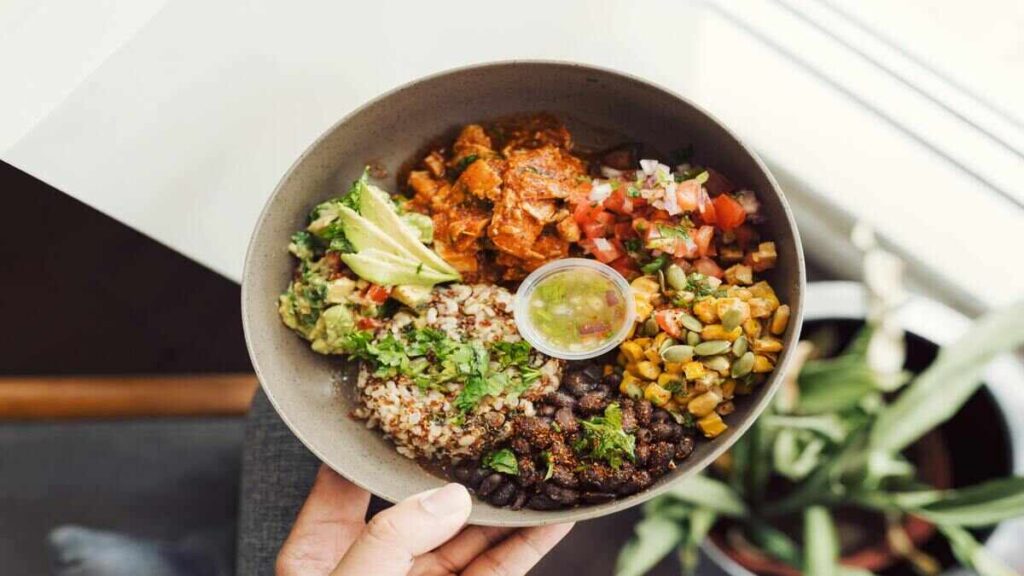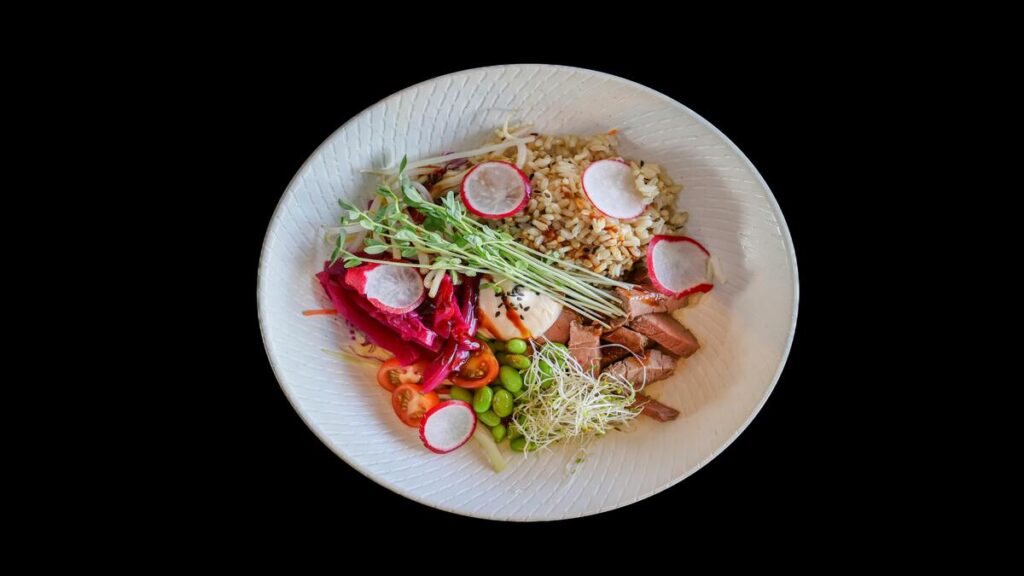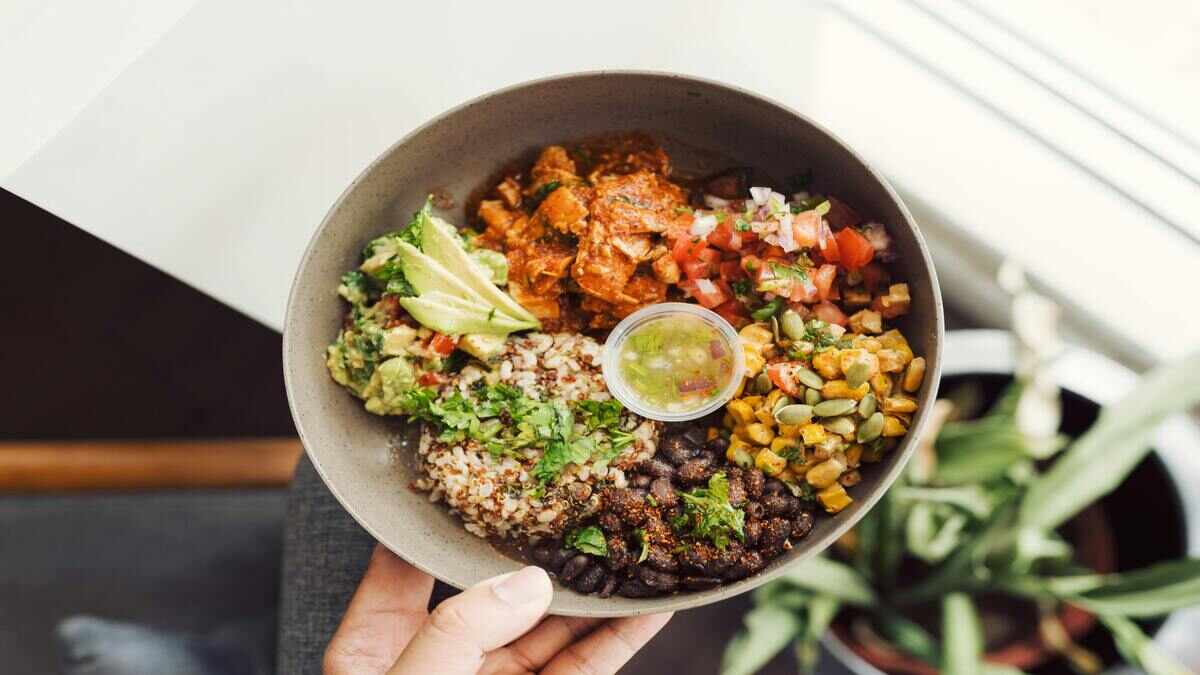In recent years, the Vegan Buddha Bowl Recipe has become a popular dish for those looking for a healthy, plant-based meal that’s as satisfying as it is nourishing. A colorful, well-balanced bowl filled with whole foods—grains, veggies, protein, healthy fats, and a delicious dressing—Buddha bowls are not only delicious but are also packed with essential nutrients that support overall health. Whether you’re new to plant-based eating or just looking for a nutritious and vibrant meal, this blog post will give you a complete guide on vegan Buddha bowls. We’ll cover everything from the origins to the best way to prepare and serve them.
What is a Vegan Buddha Bowl Recipe?
A Vegan Buddha Bowl Recipe is a meal that’s typically served in a bowl, featuring a variety of ingredients that are balanced to provide a wide range of nutrients. These bowls are made up of whole grains, vegetables, legumes or plant-based proteins, healthy fats, and topped off with a flavorful dressing. The beauty of a Buddha bowl lies in its versatility—there are no hard and fast rules, and you can easily customize it based on your taste preferences and what’s available in your pantry or fridge.
The goal is to create a colorful, nutrient-packed bowl that’s visually appealing and incredibly satisfying. Whether you’re vegan, vegetarian, or just looking to add more plant-based meals to your diet, the Buddha bowl is a perfect choice.
The Origins of the Vegan Buddha Bowl Recipe
The origins of the Vegan Buddha Bowl Recipe are somewhat unclear, but it’s believed to have been inspired by Buddhist monks, who would often carry a bowl to receive offerings of food. These offerings were usually a variety of simple, whole foods that provided nourishment, and the combination of different food items in the bowl represented balance.
Today, the Vegan Buddha Bowl Recipe has evolved into a trendy, health-conscious dish that’s enjoyed worldwide by people looking for wholesome meals. While the name itself is somewhat symbolic, referring to balance and abundance, the Buddha bowl has become synonymous with clean, nourishing eating.

Essential Ingredients for a Vegan Buddha Bowl Recipe
Creating a vegan Buddha bowl is all about balance—balancing macronutrients (carbs, protein, fats) and a variety of textures and flavors. Here’s a breakdown of the key ingredients:
1. Whole Grains
Whole grains are a crucial component of any Buddha bowl, providing complex carbohydrates and fiber to keep you full and satisfied. Common grains to use include:
- Quinoa
- Brown rice
- Farro
- Barley
- Bulgur wheat
2. Plant-Based Proteins
To make your Buddha bowl a complete meal, it’s important to include plant-based proteins. This ensures you’re getting the necessary building blocks to support your body. Popular protein sources are:
- Chickpeas (roasted or sautéed)
- Tofu (grilled, baked, or sautéed)
- Tempeh
- Edamame
- Lentils
3. Vegetables
The veggies in a Buddha bowl are often the star of the show. They can be either raw or cooked, depending on your preference. Some great options include:
- Roasted sweet potatoes
- Kale
- Spinach
- Cucumber
- Carrots
- Avocado
- Broccoli
4. Healthy Fats
Healthy fats provide flavor and satisfaction. A few examples include:
- Avocado
- Olives
- Nuts and seeds (such as sunflower seeds, sesame seeds, or almonds)
- Tahini (which is also great for dressings)
5. Flavorful Dressings or Sauces
A good dressing ties everything together and brings the dish to life. You can experiment with:
- Tahini dressing
- Lemon-tahini sauce
- Peanut sauce
- Soy sauce and sesame oil
- Avocado dressing
Essential Equipment for Making Vegan Buddha Bowl Recipe
Making a vegan Buddha bowl is simple and requires very basic kitchen equipment. Here’s what you’ll need:
- Cutting board and knife: To chop your vegetables and proteins.
- Bowls: A large, wide bowl to arrange all the ingredients in a visually appealing way.
- Cooking pans or oven: For roasting or sautéing vegetables and proteins like tofu or tempeh.
- Saucepan: To cook grains such as quinoa, rice, or farro.
- Small containers: For preparing dressings or sauces.
Step-by-Step Guide to Preparing a Vegan Buddha Bowl Recipe
Creating your vegan Buddha bowl can be as easy or as elaborate as you want it to be. Here’s a basic guide to get you started:
Step 1: Cook the Grains
Start by cooking your choice of grain (such as quinoa, rice, or farro). Most grains take around 15-20 minutes to cook, so it’s best to get them started first.
Step 2: Prepare the Protein
If you’re using tofu, tempeh, or chickpeas, season them with your favorite spices and either bake, sauté, or roast them. For example, you could roast chickpeas with olive oil, cumin, paprika, and garlic for added flavor. If you’re using edamame, they can be boiled or steamed quickly.
Step 3: Roast or Prepare Vegetables
If you want to add roasted vegetables, such as sweet potatoes or broccoli, preheat your oven to 400°F (200°C), toss the vegetables in olive oil and seasonings, and roast them for 20-25 minutes. Alternatively, you can keep some vegetables raw, such as cucumbers, carrots, and leafy greens like spinach or kale.
Step 4: Prepare the Dressing
Combine your chosen ingredients (e.g., tahini, lemon juice, garlic, olive oil) in a small bowl and whisk until smooth. Add water if necessary to thin out the dressing to your desired consistency.
Step 5: Assemble the Buddha Bowl
Start by placing your cooked grain as the base of the bowl. Arrange your roasted or fresh vegetables and protein sources around the grain. Add a few slices of avocado, sprinkle some seeds or nuts on top, and drizzle with your dressing.

Health Benefits of Vegan Buddha Bowl Recipe
Vegan Buddha bowls offer a wealth of health benefits, thanks to the variety of whole foods included in each meal. Here are just a few:
- High in Nutrients: Packed with a variety of vegetables, legumes, and grains, Buddha bowls are full of vitamins, minerals, and antioxidants that support overall health.
- Protein-Packed: Plant-based proteins from tofu, tempeh, lentils, and chickpeas provide the building blocks your body needs for muscle repair and growth.
- Fiber-Rich: The inclusion of whole grains and vegetables helps boost fiber intake, which supports digestive health and promotes feelings of fullness.
- Anti-Inflammatory: Many of the ingredients in a Buddha bowl, such as avocado, leafy greens, and nuts, are rich in anti-inflammatory compounds that help reduce inflammation in the body.
Best Way to Serve a Vegan Buddha Bowl Recipe
The beauty of a Buddha bowl lies in its customization, and there’s no right or wrong way to serve it. However, here are a few tips for serving your vegan Buddha bowl:
- Presentation Matters: Arrange the ingredients artfully in the bowl, with each element clearly visible to make the dish look as appealing as it is delicious.
- Add a Crunch: Include a handful of seeds, nuts, or even roasted chickpeas to add some crunch to your Buddha bowl.
- Serve with a Side: You can serve your Buddha bowl with a side of flatbread, roasted sweet potato fries, or a small salad to make the meal more substantial.
Calories, Prep Time, and Cook Time
- Calories: A typical vegan Buddha bowl can range from 400 to 600 calories, depending on the portion sizes and ingredients used. If you include calorie-dense ingredients like avocado and nuts, the calorie content will be higher.
- Prep Time: 10-15 minutes (excluding cooking time for grains and roasting veggies).
- Cook Time: 20-30 minutes, depending on the cooking methods for your grains and proteins.
Conclusion
Vegan Buddha Bowl Recipe are a versatile, wholesome, and nutrient-packed meal that anyone can enjoy, regardless of dietary preference. They are a great way to incorporate more plant-based foods into your diet while ensuring you get a balanced, delicious, and satisfying meal. Whether you’re preparing them for lunch, dinner, or even meal prep for the week, the vegan Buddha bowl is a fantastic choice for nourishing your body and your taste buds.
FAQs About Vegan Vegan Buddha Bowl Recipe
Q: Can I make a Buddha bowl in advance?
A: Yes! Buddha bowls are great for meal prep. Just keep the components separate until you’re ready to eat to prevent the grains and veggies from getting soggy.
Q: Can I make a Buddha bowl without grains?
A: Absolutely! If you’re following a low-carb or keto diet, you can omit the grains and use more vegetables or leafy greens as the base of your bowl.
Q: Can I add meat to a Vegan Buddha Bowl Recipe?
A: Yes, if you’re not strictly vegan, you can add grilled chicken, shrimp, or even beef as your protein source.
